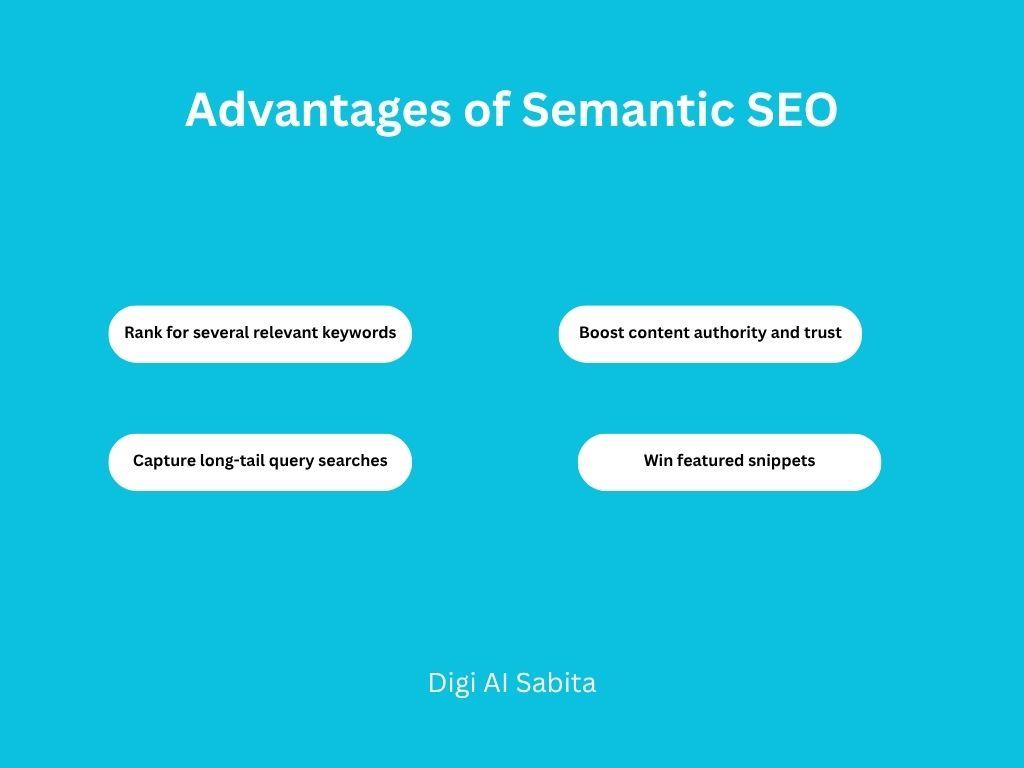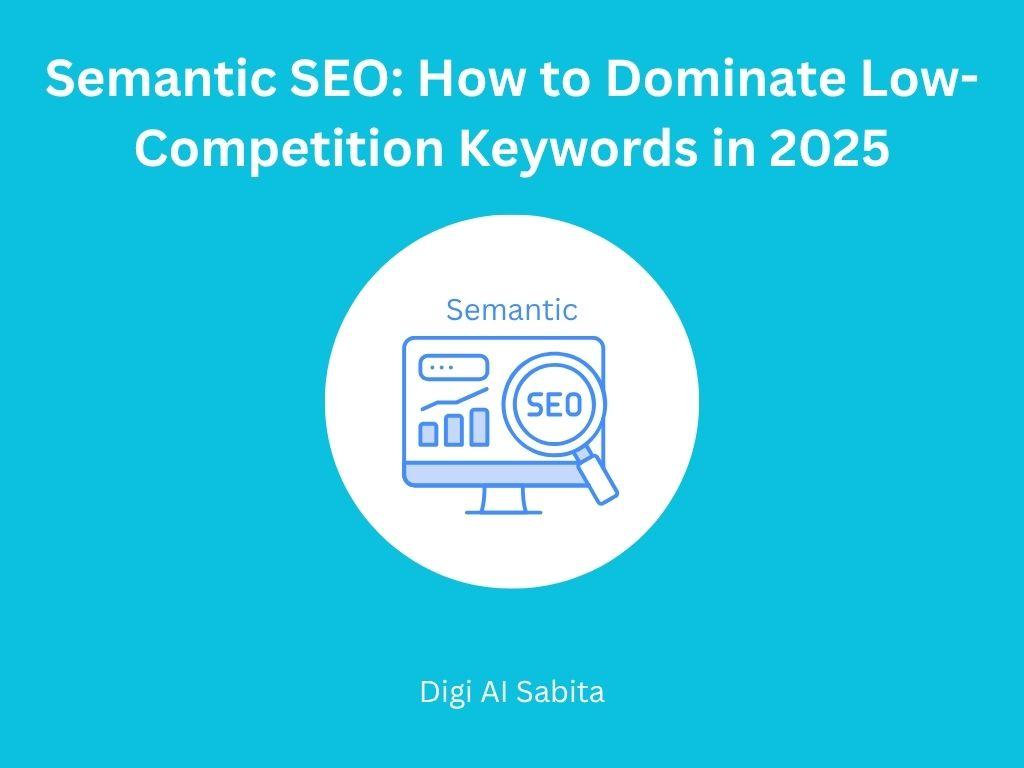Introduction: Semantic SEO in 2025
The mindset of people is changing day by day, and these changes are affecting search engine optimization (SEO). Google ranking is not as much about keyword stuffing in your content. It’s Semantic SEO, a robust technique that centers around meaning, context, and intent in 2025. If you’re struggling with industry leaders for high-volume keywords, it’s time to change your game.
Here is a post that will show you how to win low-competition keywords with semantic SEO strategies. As a blogger, marketer, or small business owner, this technique will enable you to rank smarter.
- What Is Semantic SEO?
- Why Semantic SEO Is Important in 2025
- Advantages of Semantic SEO
- Step-by-Step: Semantic SEO
- 1. Find Low-Competition, High-Intent Keywords
- 2. Create a Semantic Keyword Collection
- 3. Write Deep, Contextual Content
- 4. Optimize for Entities and Topics (Not Just Keywords)
- 5. Use Schema Markup and Structured Data
- 6. Build Topic Clusters and Internal Linking
- 7. Refresh and Update Your Content on a Regular Basis
- Real-Life Story: A Semantic SEO Strategy in Action
- Traditional SEO vs. Semantic SEO
- Conclusion:
- Call to Action
- (FAQs):
- You may like:
What Is Semantic SEO?
This type of SEO refers to generating content that assists with the searcher’s intent and context, rather than the actual words they type. It takes lots of benefits of concepts like.
- Natural language processing (NLP)
- Topic clustering
- Entity-based optimization
- Latent Semantic Indexing (LSI)
Simply understand that you’re making search engines smarter about what your content is about; it isn’t necessarily what it says.
Why Semantic SEO Is Important in 2025
Search engines, particularly Google, have evolved with AI models such as BERT and MUM. These models read:
- Intent of a search
- Word relationships
- Context surrounding topics
These things help you to convert your content to express actual meaning and relevance, not simply contain a list of keywords.
Advantages of Semantic SEO

There are so many benefits, and they are
- Rank for several relevant keywords.
- Capture long-tail query searches.
- Boost content authority and trust.
- Win featured snippets and People Also Ask boxes.
Step-by-Step: Semantic SEO
1. Find Low-Competition, High-Intent Keywords
Search for keywords that have
- Low Keyword Difficulty (KD below 30)
- Transparent search intent (informational, navigational, transactional)
- Long-tail wording (4+ words)
Tools to use:
- Ubersuggest
- LowFruits.io
- Google Search Console
- Answer The Public
For example, rather than selecting “SEO tools,” target “best free SEO tools for bloggers 2025.”
2. Create a Semantic Keyword Collection
Cluster keywords around the main topic and related entities.
Example cluster:
- Main topic: “Semantic SEO”
- Related words: “topic clusters,” “entity-based SEO,” “content relationships,” “LSI keywords,” “Google NLP,” “search intent optimization”
Utilize tools such as
- LSIGraph
- SurferSEO
- Google’s NLP API demo
3. Write Deep, Contextual Content
Depth and context reward Google. Here’s how to make semantically rich content:
- Cover all sides of a topic.
- Naturally use related terms and synonyms.
- Incorporate FAQs and respond to follow-up questions.
- Use internal links to relevant content.
- Make content readable (H2s, bullets, visuals).
Don’t keyword stuff. Rather, use natural language and meaning instead.
4. Optimize for Entities and Topics (Not Just Keywords)
Entities = individuals, locations, brands, events, etc.
Instead of improving for just “SEO tips,” include entities like
- “Google Search Central”
- “Yoast SEO plugin”
- “BERT update”
This assists Google in understanding your content’s credibility and applicability.
5. Use Schema Markup and Structured Data
Add schema to enhance how your content looks in search.
Recommended Schema Types:
- Article
- FAQPage
- HowTo
- Product (for e-commerce)
- Author
Tools:
- Schema.org
- Google’s Rich Results Test
- RankMath or Yoast plugins
This boosts your likelihood of showing in rich snippets.
6. Build Topic Clusters and Internal Linking
A topic cluster strategy enhances SEO authority by linking related content.
How to organize:
- Pillar Page (general topic such as “Semantic SEO Guide”)
- Cluster Content (subtopics such as “LSI keywords,” “Search intent,” and “Topic clusters”)
Connect them together with contextual anchor texts to build topical depth.
7. Refresh and Update Your Content on a Regular Basis
Freshness counts more than ever in 2025. Google monitors:
- Date published
- Last update
- New sections or examples added
- Utilize content audits to:
- Update statistics
- Include new subtopics
- Re-target based on Search Console data
Real-Life Story: A Semantic SEO Strategy in Action
Suppose you’re writing about “free SEO tools.”
Rather than one simple list, your content could contain:
- On-page, off-page, and technical: types of SEO tools
- Blogger, small business, agency: tools for each role
- Individual tool reviews in-depth
- Step-by-step tutorial on using them
- Beginner pitfalls
- People Also Ask-style FAQs
Traditional SEO vs. Semantic SEO
The difference between traditional and semantic SEO is that traditional SEO depends heavily on specific keywords, but semantic SEO relies on content depth, which studies word meanings and the relationship between the meanings behind the words.
Conclusion:
2025 can be a game-changer if you utilize semantic SEO wisely. It empowers you to rank for low-competition keywords, establish authority, and draw highly targeted traffic by leveraging context and meaning.
No matter if you’re working on a blog, marketing a service, or developing a brand, this plan is your ticket to long-term success.
Call to Action
Ready to support semantic SEO?
Start now by scanning your existing content for holes in context. Next, apply a topic collection approach to generate new, optimized pieces. Struggling to get started? Let us help you a free guide for content audit!
(FAQs):
1. What is the main objective of semantic SEO?
The purpose of this SEO is to assist search engines in understanding the sense and structure of your content so that it gets ranked higher for user intent, not keywords alone.
2. Is it suitable for low-competition keywords?
Yes! It works magically for long-tail, low-competition keywords because you can rank for various differential and related searches with a single well-crafted post.
3. Do I need any special tools for semantic SEO?
No, it isn’t necessarily. You can use free resources such as Google Search Console and AnswerThePublic. But paid resources such as SurferSEO, MarketMuse, or Clearscope simplify the process.
4. How long does it take to see results?
This SEO can release quicker results compared to conventional methods, particularly when using low-competition keywords. You can see appreciable changes within 2–6 weeks based on content quality and niche.
5. Can I use AI for semantic SEO?
Yes. You can use AI tools like ChatGPT, Jasper, and Writesonic to generate topic-heavy content, FAQs, and keyword variations. Just remember to check reality and edit for readability.
